Solar minimum is here - but even now strangely beautiful auroras are dancing around the poles. Deep inside the Arctic Circle, the expert guides of Aurora Holidays in Utsjoki, Finland, can help you chase them. Book now! | | |
BE ALERT FOR THE "LUNAR X": Have you seen the Lunar X? Once a month when the sun rises over Crater Werner in the Moon's southern hemisphere, sunlight floods the region's high terrain and makes a luminous criss-cross shape. The "X" is due to appear on Sunday, June 9th, between 20.4h and 22.4h Pacific Daylight Time. Submit your X's here.
HUGE OUTBREAK OF NOCTILUCENT CLOUDS: Last night, a huge outbreak of noctilucent clouds (NLCs) occurred as tendrils of frosted meteor smoke were sighted in Europe and the USA as far south as Oregon and Utah. "What a surprise," says Andrew Robb of Beaverton OR. "It's been almost 10 years since I've seen NLCs here in Oregon. They're back!"
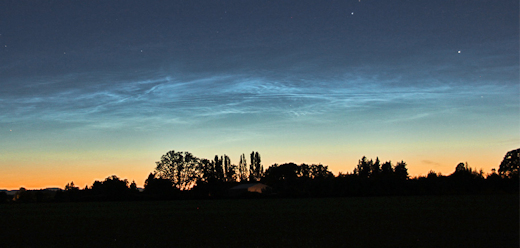
Robb took the picture, above, just after sunset on June 8th. "NLCs stretched the length of the whole horizon," he says. "Their rippling waves and other structures were fascinating."
NLCs are Earth's highest clouds. Seeded by meteoroids, they float at the edge of space more than 80 km above the planet's surface. The clouds are very cold and filled with tiny ice crystals. When sunbeams hit those crystals, they glow electric-blue.
Normally, NLCs are confined to polar regions, but this year people are seeing them at middle latitudes, too. Last night alone the clouds appeared in Utah, Minnesota, Wisconsin, Washington, Montana, Iowa, Oregon and Maine. Electric-blue ripples also blanketed much of northern to central Europe. This is what sunrise over Poland looked like on June 9th:
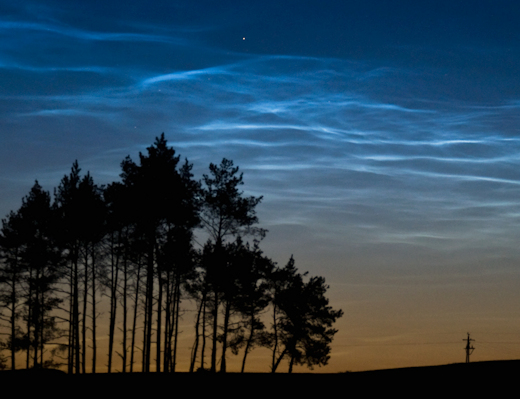
"It was such a beautiful display of noctilucent clouds," says photographer Marek Nikodem of Szubin, Poland.
Why are noctilucent clouds suddenly so bright? Previous studies have shown that noctilucent clouds sometimes intensify during solar minimum. Solar minimum conditions are in effect now as the sun has been without spots for 21 consecutive days--a situation that may favor the frosting of meteor smoke high above Earth.
At present, no one can predict exactly when noctilucent clouds will appear. Last night's display, however, suggests that more of the clouds may be in the offing even at mid-latitudes. Observing tips: Look west 30 to 60 minutes after sunset when the sun has dipped below the horizon. If you see luminous blue-white tendrils spreading across the sky, you may have spotted a noctilucent cloud.
Realtime Noctilucent Cloud Photo Gallery
Free: Spaceweather.com Newsletter
FATHER'S DAY GIFTS FROM THE EDGE OF SPACE: What do you get the dad who has everything? Consider a gift from the edge of space! Every item in the Earth to Sky Store has flown to the top of Earth's atmosphere onboard a cosmic ray balloon, and they're all 10% off between now and Father's Day (June 16th).

Each gift comes with a unique greeting card showing the item in flight and telling the story of its journey to the stratosphere and back again. Cosmic ray data collected during the flights form a unique record of radiation in Earth's atmosphere--100% gathered and analyzed by young scientists. All sales support the students and their high-altitude ballooning program. Thanks!
Far Out Gifts: Earth to Sky Store
All sales support hands-on STEM education
UNEXPECTED CME IMPACT: On Saturday, June 8th, a dense and strongly-magnetized cloud of plasma hit Earth's magnetic field. It was, apparently, the flank of a coronal mass ejection (CME). The solar storm cloud left the sun with little fanfare on June 3rd. Coronagraphs on NASA's STEREO-A spacecraft barely detected it:
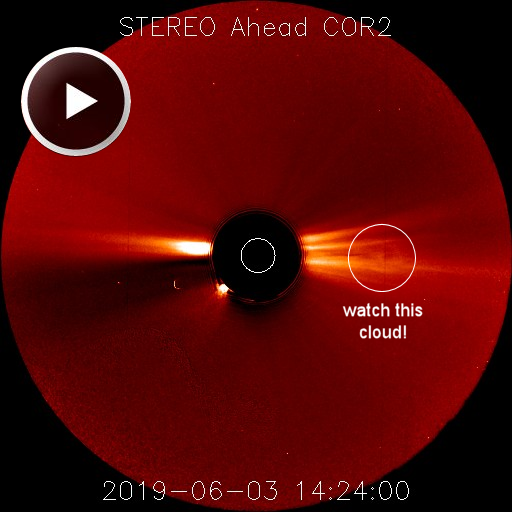
The slow-moving CME took more than 5 days to cross the sun-Earth divide. Typical CMEs cross the same distance in half the time. Despite its low velocity, the CME was geoeffective. Strong south-pointing magnetic fields inside the CME opened cracks in Earth's magnetosphere. Solar wind poured through the gaps to spark a G1-class geomagnetic storm on June 8th.
The effects of the CME are subsiding now and no further storms are expected this weekend. Aurora alerts: SMS Text, Email.
Realtime Aurora Photo Gallery
Free: Spaceweather.com Newsletter
Realtime Space Weather Photo Gallery
Free: Spaceweather.com Newsletter
Every night, a network of
NASA all-sky cameras scans the skies above the United States for meteoritic fireballs. Automated software maintained by NASA's Meteoroid Environment Office calculates their orbits, velocity, penetration depth in Earth's atmosphere and many other characteristics. Daily results are presented here on Spaceweather.com.
On Jun. 9, 2019, the network reported 4 fireballs.
(4 sporadics)
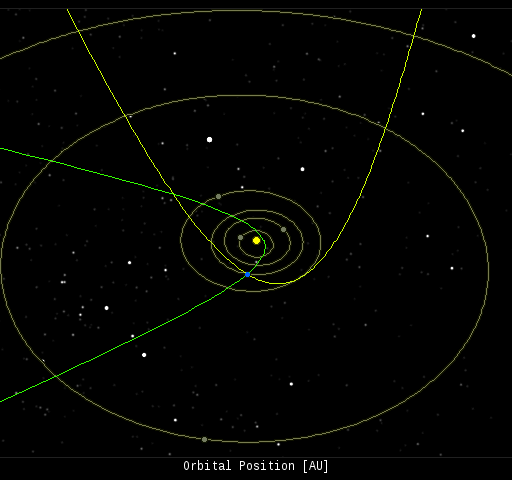
In this diagram of the inner solar system, all of the fireball orbits intersect at a single point--Earth. The orbits are color-coded by velocity, from slow (red) to fast (blue). [Larger image] [movies]
Potentially Hazardous Asteroids (
PHAs) are space rocks larger than approximately 100m that can come closer to Earth than 0.05 AU. None of the known PHAs is on a collision course with our planet, although astronomers are finding
new ones all the time.
On June 9, 2019 there were 1983 potentially hazardous asteroids.
 |
Recent & Upcoming Earth-asteroid encounters: | Asteroid | Date(UT) | Miss Distance | Velocity (km/s) | Diameter (m) |
| 2019 KE2 | 2019-Jun-04 | 19.9 LD | 9.3 | 48 |
| 2019 KY | 2019-Jun-04 | 5.5 LD | 6.2 | 19 |
| 2019 KS | 2019-Jun-04 | 12.3 LD | 17.6 | 44 |
| 2019 KA4 | 2019-Jun-05 | 8.4 LD | 7.2 | 23 |
| 2019 KA3 | 2019-Jun-06 | 4 LD | 3.9 | 9 |
| 2019 JX2 | 2019-Jun-06 | 13.8 LD | 7 | 41 |
| 2014 MF18 | 2019-Jun-06 | 8.8 LD | 3 | 22 |
| 2019 LA | 2019-Jun-07 | 13.9 LD | 22.3 | 68 |
| 2019 KZ3 | 2019-Jun-07 | 5.7 LD | 10 | 52 |
| 2019 KG3 | 2019-Jun-11 | 16.4 LD | 6.8 | 23 |
| 2019 LB | 2019-Jun-12 | 9.1 LD | 6 | 33 |
| 2019 LL1 | 2019-Jun-14 | 5.6 LD | 8.8 | 16 |
| 2013 YA14 | 2019-Jun-14 | 14.7 LD | 11.1 | 65 |
| 2019 KJ | 2019-Jun-14 | 12.6 LD | 8.1 | 68 |
| 2019 LU | 2019-Jun-16 | 4.1 LD | 8 | 35 |
| 2019 LR | 2019-Jun-16 | 18.3 LD | 15 | 34 |
| 2019 LC1 | 2019-Jun-19 | 19.2 LD | 9.9 | 26 |
| 2019 LB2 | 2019-Jun-20 | 6.5 LD | 3.4 | 15 |
| 2019 LM1 | 2019-Jun-23 | 9.8 LD | 8.7 | 26 |
| 441987 | 2019-Jun-24 | 7.7 LD | 12.6 | 178 |
| 2008 KV2 | 2019-Jun-27 | 17.8 LD | 11.4 | 195 |
| 2016 NN15 | 2019-Jun-28 | 9.6 LD | 8.4 | 16 |
| 2019 LV1 | 2019-Jun-29 | 5.2 LD | 6.2 | 24 |
| 2015 XC352 | 2019-Jul-01 | 11.9 LD | 4.1 | 26 |
| 2016 OF | 2019-Jul-07 | 12.8 LD | 8.5 | 85 |
| 2016 NO56 | 2019-Jul-07 | 3.4 LD | 12.2 | 26 |
| 2019 KD3 | 2019-Jul-12 | 15.5 LD | 8 | 89 |
| 2016 NJ33 | 2019-Jul-12 | 15 LD | 4.5 | 32 |
| 2015 HM10 | 2019-Jul-24 | 12.2 LD | 9.5 | 68 |
| 2010 PK9 | 2019-Jul-26 | 8.2 LD | 16.5 | 155 |
Notes: LD means "Lunar Distance." 1 LD = 384,401 km, the distance between Earth and the Moon. 1 LD also equals 0.00256 AU. MAG is the visual magnitude of the asteroid on the date of closest approach. | | Cosmic Rays in the Atmosphere |
SOMETHING NEW! We have developed a new predictive model of aviation radiation. It's called E-RAD--short for Empirical RADiation model. We are constantly flying radiation sensors onboard airplanes over the US and and around the world, so far collecting more than 22,000 gps-tagged radiation measurements. Using this unique dataset, we can predict the dosage on any flight over the USA with an error no worse than 15%.
E-RAD lets us do something new: Every day we monitor approximately 1400 flights criss-crossing the 10 busiest routes in the continental USA. Typically, this includes more than 80,000 passengers per day. E-RAD calculates the radiation exposure for every single flight.
The Hot Flights Table is a daily summary of these calculations. It shows the 5 charter flights with the highest dose rates; the 5 commercial flights with the highest dose rates; 5 commercial flights with near-average dose rates; and the 5 commercial flights with the lowest dose rates. Passengers typically experience dose rates that are 20 to 70 times higher than natural radiation at sea level.
To measure radiation on airplanes, we use the same sensors we fly to the stratosphere onboard Earth to Sky Calculus cosmic ray balloons: neutron bubble chambers and X-ray/gamma-ray Geiger tubes sensitive to energies between 10 keV and 20 MeV. These energies span the range of medical X-ray machines and airport security scanners.
Column definitions: (1) The flight number; (2) The maximum dose rate during the flight, expressed in units of natural radiation at sea level; (3) The maximum altitude of the plane in feet above sea level; (4) Departure city; (5) Arrival city; (6) Duration of the flight.
SPACE WEATHER BALLOON DATA: Approximately once a week, Spaceweather.com and the students of Earth to Sky Calculus fly space weather balloons to the stratosphere over California. These balloons are equipped with radiation sensors that detect cosmic rays, a surprisingly "down to Earth" form of space weather. Cosmic rays can seed clouds, trigger lightning, and penetrate commercial airplanes. Furthermore, there are studies ( #1, #2, #3, #4) linking cosmic rays with cardiac arrhythmias and sudden cardiac death in the general population. Our latest measurements show that cosmic rays are intensifying, with an increase of more than 18% since 2015:
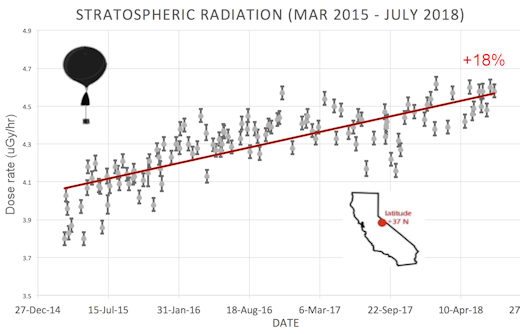
The data points in the graph above correspond to the peak of the Reneger-Pfotzer maximum, which lies about 67,000 feet above central California. When cosmic rays crash into Earth's atmosphere, they produce a spray of secondary particles that is most intense at the entrance to the stratosphere. Physicists Eric Reneger and Georg Pfotzer discovered the maximum using balloons in the 1930s and it is what we are measuring today.
En route to the stratosphere, our sensors also pass through aviation altitudes:
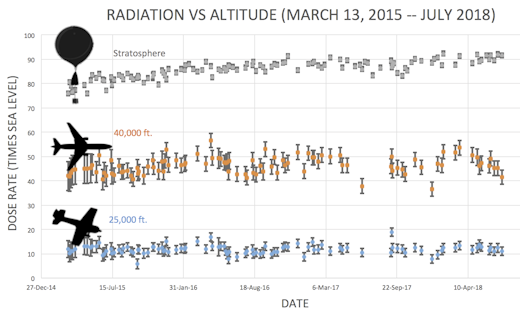
In this plot, dose rates are expessed as multiples of sea level. For instance, we see that boarding a plane that flies at 25,000 feet exposes passengers to dose rates ~10x higher than sea level. At 40,000 feet, the multiplier is closer to 50x.
The radiation sensors onboard our helium balloons detect X-rays and gamma-rays in the energy range 10 keV to 20 MeV. These energies span the range of medical X-ray machines and airport security scanners.
Why are cosmic rays intensifying? The main reason is the sun. Solar storm clouds such as coronal mass ejections (CMEs) sweep aside cosmic rays when they pass by Earth. During Solar Maximum, CMEs are abundant and cosmic rays are held at bay. Now, however, the solar cycle is swinging toward Solar Minimum, allowing cosmic rays to return. Another reason could be the weakening of Earth's magnetic field, which helps protect us from deep-space radiation.
| | The official U.S. government space weather bureau |
| | The first place to look for information about sundogs, pillars, rainbows and related phenomena. |
| | Researchers call it a "Hubble for the sun." SDO is the most advanced solar observatory ever. |
| | 3D views of the sun from NASA's Solar and Terrestrial Relations Observatory |
| | Realtime and archival images of the Sun from SOHO. |
| | from the NOAA Space Environment Center |
| | fun to read, but should be taken with a grain of salt! Forecasts looking ahead more than a few days are often wrong. |
| | from the NOAA Space Environment Center |
| | the underlying science of space weather |
 | To find reviews of new online casino sites in the UK try The Casino DB where there are hundreds of online casino reviews complete with bonuses and ratings. Looking for a new online casino? Try Casimpo the new site dedicated to making online casino simple and easy for all. |
| | These links help Spaceweather.com stay online. Thank you to our supporters! |
| | | | | | |

